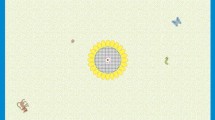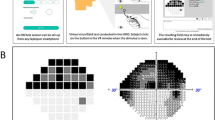Abstract
Background
We have developed a method of quantifying the central binocular visual field by merging results from monocular fields (Integrated visual field). This study aims to compare the new measure with the binocular Esterman visual field test in identifying patients with self-reported visual disability.
Methods
Forty-eight patients with glaucoma each recorded Humphrey 24-2 fields for both eyes and an Esterman on the same day, and each completed a binary forced-choice questionnaire relating to perceived visual disability. Computer software merged sensitivity values from monocular fields to generate an integrated visual field and a related score of the number of defects at the <10 dB and <20 dB level. Receiver operating characteristic (ROC) analysis was used to compare the integrated visual field score and the Esterman disability score with individual responses to the questions on perceived difficulty with visual tasks.
Results
Comparison of areas under ROC curves revealed that a score based on the integrated visual field was generally better (median area: 0.79) than Esterman scores (median area: 0.70) in classifying patients with or without a self-reported perceived difficulty with visual tasks.
Conclusions
The integrated visual field offers a rapid assessment of a glaucoma patient’s binocular visual field without extra perimetric testing. As compared to an actual binocular field test (Esterman), the integrated visual field provides a better prediction of a glaucoma patient’s perceived inability to perform certain visual tasks.



Similar content being viewed by others
References
Altman DG, Bland M (1994) Statistics notes: diagnostic tests 3: receiver operating characteristic plots. Br Med J 309:188
Crabb DP, Viswanathan AC, McNaught AI, Poinoosawmy D, Fitzke FW, Hitchings RA (1998) Simulating binocular visual field status in glaucoma. Br J Ophthalmol 82:1236–1241
Esterman B (1982) Functional scoring of the binocular field. Ophthalmology 89:1226–1234
Fitzke FW, Hitchings RA, Poinoosawmy D, McNaught AI, Crabb DP (1996) Analysis of visual field progression in glaucoma. Br J Ophthalmol 80:40–48
Friedman SM, Munoz B, Rubin GS, West SK, Bandeen-Roche K, Fried LP (1999) Characteristics of discrepancies between self-reported visual function and measured reading speed. Salisbury Eye Evaluation Project Team. Invest Ophthalmol Vis Sci 40:858–864
Hanley JA, McNeil BJ (1983) A method of comparing the areas under receiver operating characteristic curves derived from the same cases. Radiology 148:839–843
Harris ML, Jacobs NA (1995) Is the Esterman binocular field sensitive enough? In: Mills RP, Wall M (eds) Perimetry Update 1994/95. Kugler, Amsterdam, pp 13–24
Hoeymans N, Feskens EJ, van den Bos GA, Kromhout D (1996) Measuring functional status: cross-sectional and longitudinal associations between performance and self-report (Zutphen Elderly Study 1990–1993). J Clin Epidemiol 49:1103–1110
Iester M, Zingirian M (2002) Quality of life in patients with early, moderate and advanced glaucoma. Eye 16:44–49
Jampel HD, Friedman DS, Quigley H, Miller R (2002) Correlation of the binocular visual field with patient assessment of vision. Invest Ophthalmol Vis 43:1059–1067
Jampel HD, Schwartz A, Pollack I, Abrams D, Weiss H, Miller R (2002) Glaucoma patients’ assessment of their visual function and quality of life. J Glaucoma 11:154–163
Mills RP, Drance SM (1986) Esterman disability rating in severe glaucoma. Ophthalmology 93:371–378
Nelson, P, Aspinall P, Papasouliotis O, Worton B, O’Brien C (2003) Quality of life in glaucoma and its relationship with visual function. J Glaucoma 12:139–150
Nelson-Quigg JM, Cello K, Johnson CA (2000) Predicting binocular visual field sensitivity from monocular visual field results. Invest Ophthalmol Vis Sci 41:2212–2221
Noe G, Ferraro J, Lamoureux E, Rait J, Keeffe JE (2003) Associations between glaucomatous visual field loss and participation in activities of daily living. Clin Experiment Ophthalmol 31:482–486
Parrish RK, Gedde SJ, Scott IU, Feuer WJ, Schiffman JC, Mangione CM, Montenegro-Piniella A (1997) Visual function and quality of life among patients with glaucoma. Arch Ophthalmol 115:1447–1455
Scott IU, Feuer WJ, Jacko JA (2002) Impact of graphical user interface screen features on computer task accuracy and speed in a cohort of patients with age-related macular degeneration. Am J Ophthalmol 134:857–862
Smith TL (1985) The effects of regression towards the mean on visual disability ratings. Doc Ophthalmol Proc Ser 42:537–547
Turano KA, Rubin GS, Quigley HA (1999) Mobility performance in glaucoma. Invest Ophthalmol Vis Sci 40:2803–2809
Viswanathan AC, Fitzke FW, Hitchings RA (1997) Early detection of visual field progression in glaucoma: a comparison of PROGRESSOR and Statpac 2. Br J Ophthalmol 81:1037–1042
Viswanathan AC, McNaught AI, Poinoosawmy D, Fontana L, Crabb DP, Fitzke FW, Hitchings RA (1999) Severity and stability of glaucoma: patient perception compared with objective measurement. Arch Ophthalmol 117:450–454
Acknowledgements
This research was funded in part by the International Glaucoma Association. We would like to thank Andrew McNaught and Sammy Poinoosawmy for originally collecting this data, and we would also like to acknowledge Professor Fred Fitzke and Professor Roger Hitchings for their contribution to the original study.
Disclosure of interest: ACV is one of the developers of the PROGRESSOR software used in this study. DPC has no commercial interest.
Author information
Authors and Affiliations
Corresponding author
Rights and permissions
About this article
Cite this article
Crabb, D.P., Viswanathan, A.C. Integrated visual fields: a new approach to measuring the binocular field of view and visual disability. Graefe's Arch Clin Exp Ophthalmol 243, 210–216 (2005). https://doi.org/10.1007/s00417-004-0984-x
Received:
Revised:
Accepted:
Published:
Issue Date:
DOI: https://doi.org/10.1007/s00417-004-0984-x




